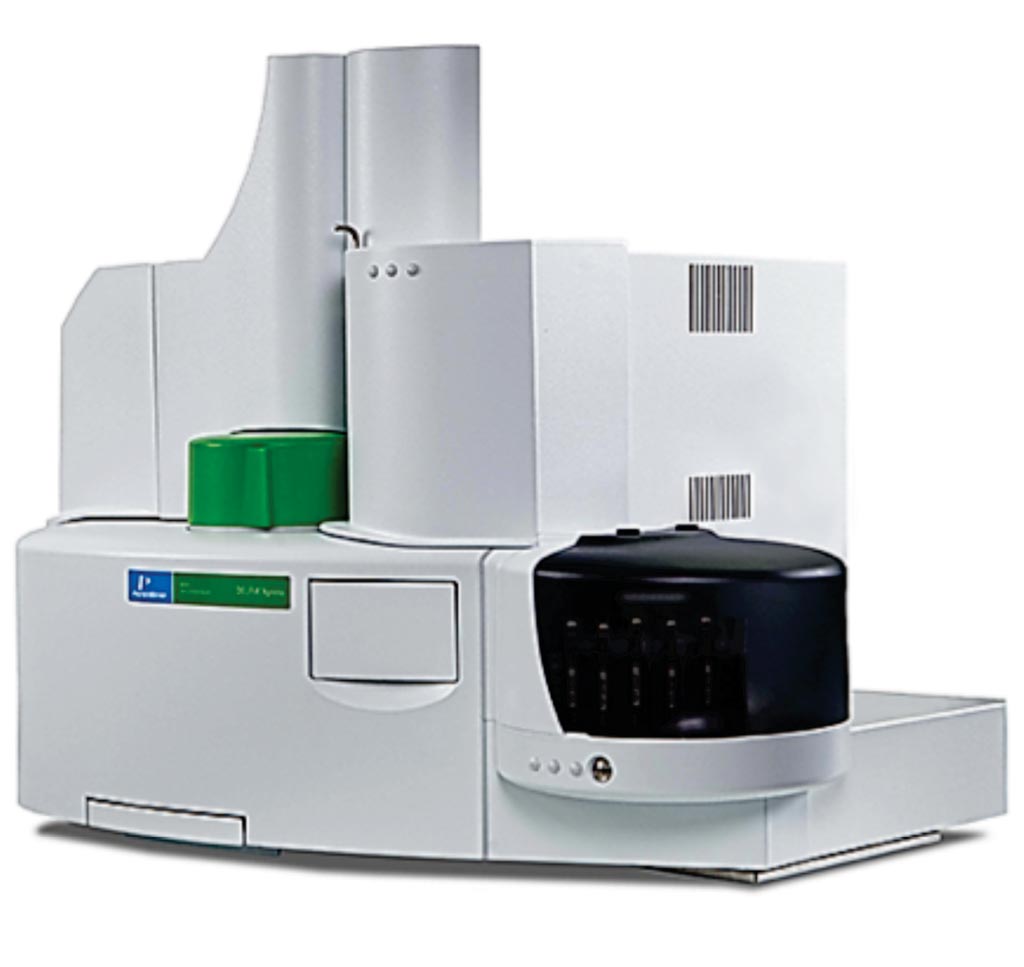Serum Biomarkers Improve Preeclampsia Screening
|
By LabMedica International staff writers Posted on 31 May 2018 |

Image: The DELFIA Xpress immunoassay analyzer for prenatal screening (Photo courtesy of PerkinElmer).
Preeclampsia (PE), which complicates 2% to 3% of pregnancies, is a major cause of mortality and morbidity for the mother and perinatal death and impairment for the baby.
A screening method for predicting preeclampsia based on the mother’s risk factors and biomarker measurements outperforms a standard method based only on maternal characteristics and medical history.
Scientists at King's College Hospital (London, UK) and their colleagues carried out a prospective multicenter study screening program for preeclampsia (SPREE) in seven National Health Service maternity hospitals in England, of women recruited between April and December 2016. The study involved 16,747 women between 11 and 13 weeks’ gestation who were assessed. The new screening method being evaluated in SPREE included not only maternal characteristics but also measurement of different combinations of mean arterial pressure (MAP), uterine artery pulsatility index (UtA-PI), serum placental growth factor (PlGF), and serum pregnancy-associated plasma protein-A (PAPP-A).
Maternal serum concentrations of PAPP‐A and PlGF were measured using one of two automated devices: DELFIA Xpress analyzer or the BRAHMS KRYPTOR analyzer. In all, 2.8% of participants developed preeclampsia; just 0.8% developed preterm preeclampsia, defined as requiring delivery before 37 weeks. The standard recommended method screened positive for 30.4% and 40.8% of all preeclampsia and preterm preeclampsia cases, respectively. In contrast, the new method combining maternal characteristics, MAP, and PAPP-A screened positive for 42.5% of all preeclampsia cases. Including PlGF and UtA-PI screened positive for 82.4% of all preterm preeclampsia cases.
The authors concluded that the performance of screening is substantially improved by a method combining maternal factors with biomarkers. Liona Poon, MD, a clinical senior lecturer and co-author of the study, said, “The SPREE study has provided definitive proof to support risk-based screening for preterm-preeclampsia using various biomarkers. It is now time to revise the professional guidelines and to move away from using a checklist-based method for screening.” The study was published originally published online on March 14, 2018, in the journal Ultrasound in Obstetrics Gynecology.
Related Links:
King's College Hospital
A screening method for predicting preeclampsia based on the mother’s risk factors and biomarker measurements outperforms a standard method based only on maternal characteristics and medical history.
Scientists at King's College Hospital (London, UK) and their colleagues carried out a prospective multicenter study screening program for preeclampsia (SPREE) in seven National Health Service maternity hospitals in England, of women recruited between April and December 2016. The study involved 16,747 women between 11 and 13 weeks’ gestation who were assessed. The new screening method being evaluated in SPREE included not only maternal characteristics but also measurement of different combinations of mean arterial pressure (MAP), uterine artery pulsatility index (UtA-PI), serum placental growth factor (PlGF), and serum pregnancy-associated plasma protein-A (PAPP-A).
Maternal serum concentrations of PAPP‐A and PlGF were measured using one of two automated devices: DELFIA Xpress analyzer or the BRAHMS KRYPTOR analyzer. In all, 2.8% of participants developed preeclampsia; just 0.8% developed preterm preeclampsia, defined as requiring delivery before 37 weeks. The standard recommended method screened positive for 30.4% and 40.8% of all preeclampsia and preterm preeclampsia cases, respectively. In contrast, the new method combining maternal characteristics, MAP, and PAPP-A screened positive for 42.5% of all preeclampsia cases. Including PlGF and UtA-PI screened positive for 82.4% of all preterm preeclampsia cases.
The authors concluded that the performance of screening is substantially improved by a method combining maternal factors with biomarkers. Liona Poon, MD, a clinical senior lecturer and co-author of the study, said, “The SPREE study has provided definitive proof to support risk-based screening for preterm-preeclampsia using various biomarkers. It is now time to revise the professional guidelines and to move away from using a checklist-based method for screening.” The study was published originally published online on March 14, 2018, in the journal Ultrasound in Obstetrics Gynecology.
Related Links:
King's College Hospital
Latest Clinical Chem. News
- ‘Brilliantly Luminous’ Nanoscale Chemical Tool to Improve Disease Detection
- Low-Cost Portable Screening Test to Transform Kidney Disease Detection
- New Method Uses Pulsed Infrared Light to Find Cancer's 'Fingerprints' In Blood Plasma
- Carbon Nanotubes Help Build Highly Accurate Sensors for Continuous Health Monitoring
- Paper-Based Device Boosts HIV Test Accuracy from Dried Blood Samples
- AI-Powered Raman Spectroscopy Method Enables Rapid Drug Detection in Blood
- Novel LC-MS/MS Assay Detects Low Creatinine in Sweat and Saliva
- Biosensing Technology Breakthrough Paves Way for New Methods of Early Disease Detection
- New Saliva Test Rapidly Identifies Paracetamol Overdose
- POC Saliva Testing Device Predicts Heart Failure in 15 Minutes

- Screening Tool Detects Multiple Health Conditions from Single Blood Drop
- Integrated Chemistry and Immunoassay Analyzer with Extensive Assay Menu Offers Flexibility, Scalability and Data Commutability
- Rapid Drug Test to Improve Treatment for Patients Presenting to Hospital
- AI Model Detects Cancer at Lightning Speed through Sugar Analyses
- First-Ever Blood-Powered Chip Offers Real-Time Health Monitoring
- New ADLM Guidance Provides Expert Recommendations on Clinical Testing For Respiratory Viral Infections
Channels
Molecular Diagnostics
view channel
Simple Blood Test Better Predicts Heart Disease Risk
Cardiovascular diseases (CVDs) are the primary cause of death worldwide. A large proportion of these cases could be prevented by addressing lifestyle and environmental factors such as smoking, poor diet,... Read more
New Blood Test Detects 12 Common Cancers Before Symptoms Appear
Bowel cancer is the fourth most common cancer in the UK, with over 42,000 new diagnoses each year. Detecting bowel cancer in its early stages can be challenging, and as the disease progresses, survival... Read moreHematology
view channel
New Scoring System Predicts Risk of Developing Cancer from Common Blood Disorder
Clonal cytopenia of undetermined significance (CCUS) is a blood disorder commonly found in older adults, characterized by mutations in blood cells and a low blood count, but without any obvious cause or... Read more
Non-Invasive Prenatal Test for Fetal RhD Status Demonstrates 100% Accuracy
In the United States, approximately 15% of pregnant individuals are RhD-negative. However, in about 40% of these cases, the fetus is also RhD-negative, making the administration of RhoGAM unnecessary.... Read moreImmunology
view channel
Stem Cell Test Predicts Treatment Outcome for Patients with Platinum-Resistant Ovarian Cancer
Epithelial ovarian cancer frequently responds to chemotherapy initially, but eventually, the tumor develops resistance to the therapy, leading to regrowth. This resistance is partially due to the activation... Read more
Machine Learning-Enabled Blood Test Predicts Immunotherapy Response in Lymphoma Patients
Chimeric antigen receptor (CAR) T-cell therapy has emerged as one of the most promising recent developments in the treatment of blood cancers. However, over half of non-Hodgkin lymphoma (NHL) patients... Read moreMicrobiology
view channel
Handheld Device Delivers Low-Cost TB Results in Less Than One Hour
Tuberculosis (TB) remains the deadliest infectious disease globally, affecting an estimated 10 million people annually. In 2021, about 4.2 million TB cases went undiagnosed or unreported, mainly due to... Read more
New AI-Based Method Improves Diagnosis of Drug-Resistant Infections
Drug-resistant infections, particularly those caused by deadly bacteria like tuberculosis and staphylococcus, are rapidly emerging as a global health emergency. These infections are more difficult to treat,... Read more
Breakthrough Diagnostic Technology Identifies Bacterial Infections with Almost 100% Accuracy within Three Hours
Rapid and precise identification of pathogenic microbes in patient samples is essential for the effective treatment of acute infectious diseases, such as sepsis. The fluorescence in situ hybridization... Read morePathology
view channel
Sensitive and Specific DUB Enzyme Assay Kits Require Minimal Setup Without Substrate Preparation
Ubiquitination and deubiquitination are two important physiological processes in the ubiquitin-proteasome system, responsible for protein degradation in cells. Deubiquitinating (DUB) enzymes contain around... Read more
World’s First AI Model for Thyroid Cancer Diagnosis Achieves Over 90% Accuracy
Thyroid cancer is one of the most common cancers worldwide, and its precise management typically relies on two primary systems: (1) the 8th edition of the American Joint Committee on Cancer (AJCC) or ... Read more
Breakthrough Diagnostic Approach to Significantly Improve TB Detection
Tuberculosis (TB) remains the deadliest infectious disease globally, with 10.8 million new cases and 1.25 million deaths reported in 2023. Early detection through effective screening is crucial in identifying... Read more
Rapid, Ultra-Sensitive, PCR-Free Detection Method Makes Genetic Analysis More Accessible
Genetic testing has been an important method for detecting infectious diseases, diagnosing early-stage cancer, ensuring food safety, and analyzing environmental DNA. For a long time, polymerase chain reaction... Read moreTechnology
view channel
Disposable Microchip Technology Could Selectively Detect HIV in Whole Blood Samples
As of the end of 2023, approximately 40 million people globally were living with HIV, and around 630,000 individuals died from AIDS-related illnesses that same year. Despite a substantial decline in deaths... Read more
Pain-On-A-Chip Microfluidic Device Determines Types of Chronic Pain from Blood Samples
Chronic pain is a widespread condition that remains difficult to manage, and existing clinical methods for its treatment rely largely on self-reporting, which can be subjective and especially problematic... Read more
Innovative, Label-Free Ratiometric Fluorosensor Enables More Sensitive Viral RNA Detection
Viruses present a major global health risk, as demonstrated by recent pandemics, making early detection and identification essential for preventing new outbreaks. While traditional detection methods are... Read moreIndustry
view channel
Cepheid and Oxford Nanopore Technologies Partner on Advancing Automated Sequencing-Based Solutions
Cepheid (Sunnyvale, CA, USA), a leading molecular diagnostics company, and Oxford Nanopore Technologies (Oxford, UK), the company behind a new generation of sequencing-based molecular analysis technologies,... Read more
Grifols and Tecan’s IBL Collaborate on Advanced Biomarker Panels
Grifols (Barcelona, Spain), one of the world’s leading producers of plasma-derived medicines and innovative diagnostic solutions, is expanding its offer in clinical diagnostics through a strategic partnership... Read more




















